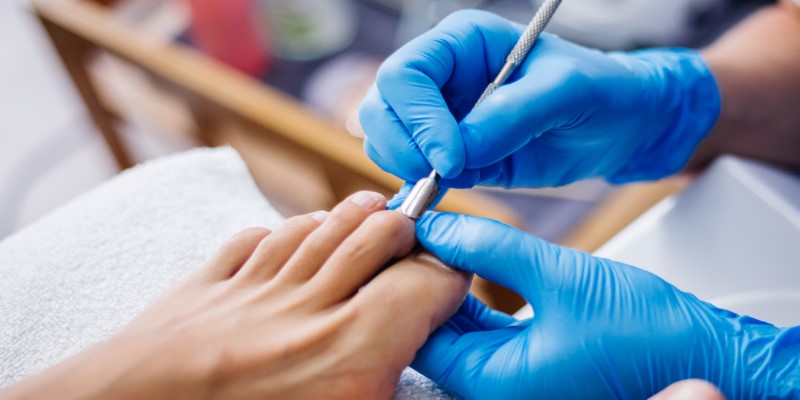From Black to Healthy: Navigating the Journey of Toenail Discoloration
Mar 07, 2024 By Nancy Miller
It's a perplexing and disturbing sight when you gaze upon your feet and discover a toenail shrouded in darkness. This occurrence, known as toenail blackening or nail discoloration, demands a thorough investigation. The objective of this article is to meticulously delve into the symptoms, causes, treatments, complications, and diagnosis associated with blackened toenails, offering invaluable insights into this frequently misunderstood matter.
By unraveling this phenomenon's intricacies, we aim to equip readers with a comprehensive understanding, empowering them to navigate the complexities of toenail discoloration confidently.
Top of Form
Symptoms and Causes of Black Toenails
Understanding the symptoms and causes behind black toenails is crucial for effective management and prevention. This section will delve into the various symptoms one might experience and the diverse causes contributing to the blackening of toenails.
Symptoms
Discoloration: One of the primary symptoms of black toenails is the noticeable color change. The toenail may range from subtle discoloration to a fully blackened appearance. Paying attention to changes in color is the first step in identifying potential issues.
Pain and Tenderness: Trauma-induced black toenails often come with pain and tenderness. If you've recently experienced an injury or impact, pain and tenderness around the affected toenail are common indicators.
Thickening and Brittleness: Fungal infections, a significant cause of black toenails, can lead to changes in nail texture. Affected nails may become thicker, more brittle, and prone to crumbling. Observing changes in nail texture is crucial for early detection.
Foul Odor: Fungal infections can sometimes produce a foul odor from the affected toenail. This unpleasant smell is a notable symptom distinguishing fungal infections from other causes of toenail discoloration.
Causes
Trauma: One of the most common causes of black toenails is trauma. Stubbing your toe, dropping a heavy object on it, or any other impact can lead to blood pooling under the nail, causing discoloration. Recognizing recent trauma is crucial in identifying this cause.
Fungal Infections: Fungal infections of the toenail, known as onychomycosis, are a prevalent cause of blackening. Fungi invade the nail bed, leading to discoloration, thickening, and brittleness. Factors like prolonged moisture exposure create an ideal environment for fungal growth.
Repetitive Microtrauma: Athletes, particularly runners, may develop black toenails due to repetitive microtrauma. Constant pressure and impact during physical activities can lead to discoloration. Ill-fitting shoes or inadequate toenail care exacerbate the risk.
Medications and Underlying Health Conditions: Certain medications, such as antimalarials or chemotherapy drugs, can cause nail discoloration as a side effect. Health conditions like psoriasis, diabetes, or circulatory issues may also contribute to black toenails.
Systemic Diseases: Systemic diseases such as peripheral arterial disease (PAD) or autoimmune disorders can affect blood flow and nail health. Toenail blackening may be a symptom of an underlying systemic issue that requires medical attention.
Treatment of Black Toenails
The appropriate treatment strategy depends on the underlying cause of toenail blackening. Tailoring interventions to the specific issue is essential for effective resolution.

Trauma Management: For trauma-induced discoloration, home remedies such as ice packs, elevation, and pain management can be beneficial. Keeping the affected toenail clean and dry is crucial to prevent infection and promote healing.
Fungal Infection Treatment: Addressing fungal infections often involves antifungal medications, either topical or oral. Over-the-counter creams may suffice for mild cases, while prescription medications may be necessary for severe infections. Maintaining proper foot hygiene is paramount to prevent recurrence.
Preventing Recurrent Microtrauma: Modifying footwear and adopting proper toenail care practices can alleviate symptoms when black toenails result from repetitive microtrauma. Selecting shoes with ample toe space and maintaining regular toenail trimming are effective preventive measures.
Addressing Underlying Health Conditions: Addressing the primary issue is paramount for discoloration linked to underlying health conditions. This may entail medication adjustments, lifestyle changes, or managing systemic diseases with professional guidance.
Complications of Black Toenails
Neglecting a black toenail or misidentifying its cause can lead to complications. Recognizing and addressing potential issues early on is crucial for optimal outcomes.
Infection Risks
Ignoring trauma-induced discoloration may lead to infection, intensifying the discoloration and causing pain. Vigilant wound care and infection prevention are essential in these cases.
Fungal Infection Complications
Untreated fungal infections can spread to other nails and even the skin. Severe cases may result in permanent nail damage, such as thickening, deformity, or loss. Individuals with compromised immune systems or underlying health conditions are at a higher risk of severe complications.
Broader Health Implications
Failure to recognize signs of underlying health conditions can have broader health implications. Timely medical attention is crucial to prevent complications and ensure the most effective treatment for both the nail issue and the underlying health concern.
Diagnosis
Determining the cause of toenail blackening requires a systematic approach involving professional examination and diagnostic tests.
Healthcare Professional Assessment: Podiatrists or dermatologists conduct a thorough examination, considering recent trauma, lifestyle factors, and overall health. This comprehensive assessment helps narrow down potential causes.

Lab Testing for Fungal Infections: A sample of the affected nail may be collected for laboratory testing in suspected fungal infections. This aids in identifying the specific fungus responsible for the discoloration.
Imaging Tests: In certain cases, imaging tests like X-rays may be conducted to rule out bone fractures or other underlying issues contributing to the toenail blackening.
Conclusion
Toenail blackening is a prevalent issue with diverse causes, ranging from trauma to fungal infections and underlying health conditions. Recognizing the symptoms, seeking timely diagnosis, and implementing appropriate treatments are crucial in addressing this concern.
Whether the cause is a stubbed toe, repetitive microtrauma, or a fungal infection, taking prompt action and consulting with healthcare professionals can prevent complications and promote optimal nail health. Remember, a black toenail is not just a cosmetic concern; it may signal an underlying issue that requires attention. Prioritize your foot health, and address toenail blackening with the thoroughness it deserves.







